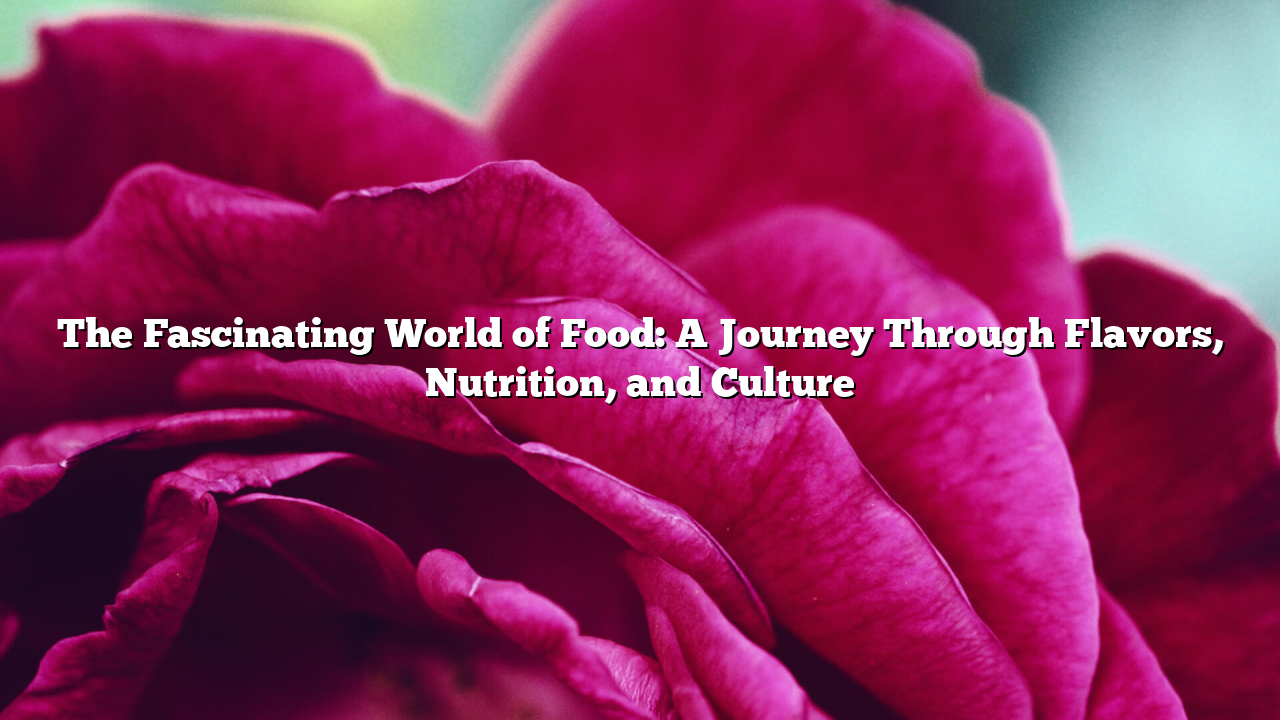Food is more than just sustenance; it’s a fundamental part of human culture, identity, and social interaction. Across the globe, food plays a pivotal role in shaping societies, reflecting histories, and offering comfort. From the street foods of Bangkok to the fine dining experiences of Paris, food is a language in itself that transcends borders. In this article, we explore the importance of food, the different cuisines around the world, and the emerging food trends that are shaping our eating habits today.
The Role of Food in Our Lives
At its core, food is essential for survival. Our bodies need a variety of nutrients to function, and these nutrients come from the foods we consume. Proteins, carbohydrates, fats, vitamins, and minerals are all required for the body to carry out its functions effectively.
However, food serves more purposes than simply keeping us alive. It brings people together, provides comfort, and often acts as an expression of cultural identity.
Food is central to celebrations and rituals. Think about the role of food in holidays and special occasions—whether it’s a Thanksgiving turkey, a birthday cake, or a Christmas ham. These meals not only fill our bellies but also evoke memories, emotions, and a sense of belonging. Sharing a meal can bring communities together, and cooking is often an expression of love and care, whether it’s a mother preparing a home-cooked meal or a chef crafting a gourmet dish.
A Taste of Global Cuisines
One of the most exciting aspects of food is its diversity. Every region of the world has its own distinct culinary traditions, shaped by local ingredients, climate, and culture. Let’s take a brief tour around the world to explore some of the most popular and iconic cuisines.
Italian Cuisine: A Celebration of Simplicity Italian food is beloved worldwide for its simplicity and emphasis on fresh, high-quality ingredients. Classic Italian dishes like pasta, pizza, and risotto are staples in many households. The use of olive oil, fresh herbs, tomatoes, and cheeses like Parmesan and mozzarella is essential to Italian cooking. Italy’s regional diversity offers a rich tapestry of flavors, from the hearty meat-based dishes of the north to the lighter seafood meals of the south.
Chinese Cuisine: A Harmonious Balance of Flavors Chinese cuisine is one of the oldest and most diverse in the world, with each region offering a unique taste experience. From the spicy, bold flavors of Sichuan cuisine to the delicate, sweet flavors of Cantonese dishes, Chinese food emphasizes balance. The use of rice, noodles, soy sauce, and a variety of meats and vegetables creates a wide array of dishes, from dim sum to Peking duck.
Mexican Cuisine: Bold, Flavorful, and Colorful Mexican food is known for its vibrant colors and bold flavors, often combining ingredients like corn, beans, chili peppers, and avocados. Dishes like tacos, enchiladas, and guacamole are enjoyed globally, while regional specialties
like mole from Oaxaca or carnitas from Michoacán offer even more variety. Mexican cuisine also has a deep connection to its indigenous roots, and its dishes reflect a rich history of agriculture, culture, and craftsmanship.
Japanese Cuisine: A Focus on Freshness and Seasonality Japanese cuisine is based on fresh, seasonal ingredients and emphasizes the beauty of presentation. Sushi, sashimi, ramen, and tempura are just a few of the many iconic dishes. The Japanese have a deep respect for nature, and this is reflected in their culinary practices, which focus on preserving the natural flavors of ingredients. Meals are often served with a sense of balance, incorporating rice, fish, vegetables, and pickled items.
Indian Cuisine: Spices That Tell a Story Indian cuisine is a feast for the senses, known for its bold use of spices. From the aromatic curries of the north to the spicier dishes of the south, Indian food offers an array of flavors. Spices like cumin, coriander, turmeric, and garam masala form the foundation of Indian cooking, and each region has its own signature dishes, such as biryani, samosas, dosas, and butter chicken. Food in India is often seen as a way to connect with the divine, and the preparation of meals can be a spiritual experience.
The Rise of Food Trends
In recent years, food trends have evolved to meet changing dietary preferences, environmental concerns, and health-conscious lifestyles. Here are a few key trends that have gained significant attention:
Plant-Based Eating As people become more aware of the environmental impact of animal agriculture and the health benefits of plant-based diets, plant-based eating has become a major trend. From veganism to flexitarianism, many people are opting for more plant-based meals. Meat alternatives like Beyond Meat and Impossible Foods have made it easier to enjoy plant-based versions of traditional dishes, while plant-based restaurants are popping up in cities around the world.
Farm-to-Table The farm-to-table movement emphasizes sourcing ingredients directly from local farmers and producers. This trend has gained traction in response to concerns about the environmental impact of industrial agriculture and the desire for fresher, more sustainable food. Farm-to-table dining not only supports local economies but also promotes seasonal eating, which can lead to healthier and more flavorful dishes.
Global Fusion As the world becomes increasingly interconnected, so does its food. Chefs and home cooks alike are experimenting with blending different culinary traditions to create innovative fusion dishes. Sushi burritos, Korean tacos, and ramen burgers are just a few examples of how global flavors are merging to create exciting new dishes that reflect a more multicultural world.
Sustainability and Zero-Waste Cooking With growing concern about food waste and sustainability, zero-waste cooking has become a popular trend. Chefs are using every part of an ingredient, from root to stem, to create innovative dishes and minimize waste. Sustainability also includes considerations for food sourcing, packaging, and energy usage in food production.
Conclusion
Food is much more than just fuel for the body; it’s a way to connect with others, experience different cultures, and express creativity. From the rich flavors of global cuisines to the evolving food trends that shape our culinary landscape, food continues to inspire, nourish, and bring joy. Whether we’re savoring a simple meal at home or exploring the exotic flavors of distant lands, food reminds us of the diverse, interconnected world we live in. So, dewaslot69 link sit down to a meal, take a moment to appreciate the flavors, the history, and the traditions that make every bite special.
Exploring the Fascinating World of Food: A Culinary Journey











Leave a Reply